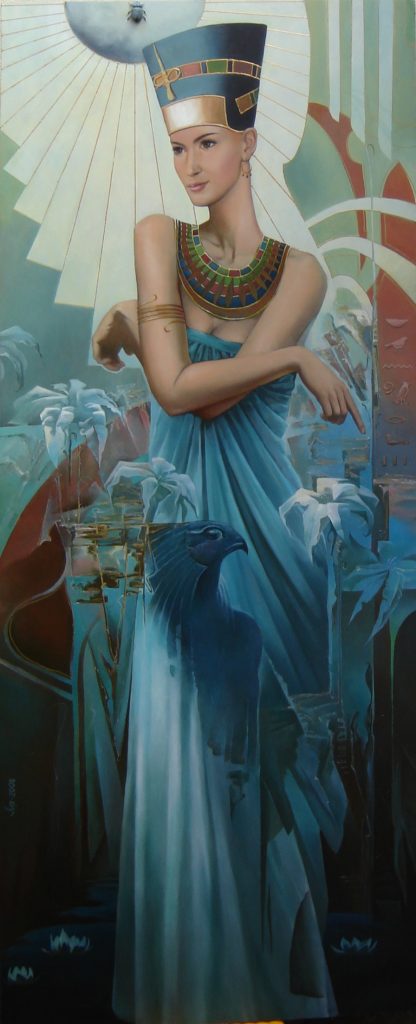Nefertiti painting Vlad Tasoff
Oil on wood panel, 2008
Nefertiti painting by Vlad Tasoff now available. Size of work: 28.7 x 70.9 inches
Price: 5500$
http://wicked-vlad.deviantart.com/art/Nefertiti-279100332 or contact us: vlta2006@yahoo.com
Nefertiti Facts:
Egyptian queen – chief wife of Pharaoh Amenhotep IV who took the name Akhenaten
Known for: appearance in Egyptian art, especially the famous bust discovered in 1912 at Amarna; part she probably played in the religious revolution centering on monotheistic worship of the sun disk, Aten
Dates: 14th century BCE, Eighteenth Dynasty.
Name: Nefertiti has been translated as “The Beautiful One Is Come”
What We Know About Nefertiti:
Nefertiti was the chief wife (queen) of the Egyptian Pharaoh Amenhotep IV who took the name Akhenaten when he led a religious revolution which put the sun god Aten at the center of religious worship. Art from the time shows a close family relationship, with Nefertiti, Akhenaten, and their six daughters depicted more naturalistically, individualistically, and informally than in other eras. Images of Nefertiti also depict her taking an active role in the Aten cult.
For the first five years of Akhenaten’s rule, Nefertiti is depicted in carved images as being a very active queen, with a much more central role in ceremonial acts of worship.
Nefertiti’s Rival?
Tutankhamen’s mother is noted in records as a woman named Kiya. She may have been a lesser wife of Akhenaten. Her hair was styled in the Nubian fashion, perhaps indicating her origin. Some images — a drawing, a tomb scene — point to the pharaoh morning her death in childbirth. Images of Kiya were, at some later time, destoyed.
What Happened to Nefertiti?
After about fourteen years, Nefertiti disappears from public view. One theory is that she died about that time.
Another theory of Nefertiti’s disappearance is that she assumed a male identity and ruled under the name Smenkhkhare after her husband’s death.
Another theory is that Nefertiti advocated returning to worship of Aten when Akhenaten and Tutankhamen had turned back to worship of Amen-re, perhaps pressured by the priestly class. As a result, she was no longer at the center politically, and may even have been murdered as part of the return to the traditional Egyptian religious customs.
A mummy thought to be Nefertiti was disfigured, with a stab wound, a fractured arm, and the face and chest attacked with a blunt instrument. These could have been the cause of the death — pointing to murder — or an attack on the corpse, indicating great hatred. The damage may have been done in retribution for her husband’s apostasy in turning from the gods supported by many of the priests. (The source of this evidence and theory is Dr. Joann Fletcher, a noted Egyptologist.)

